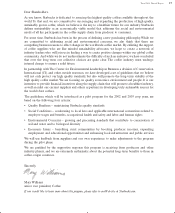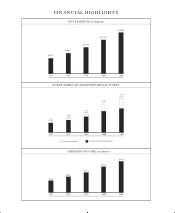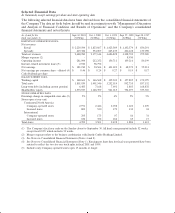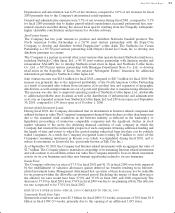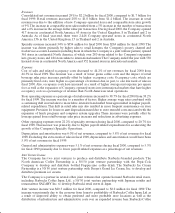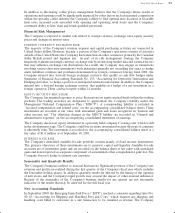Starbucks 2001 Annual Report Download - page 3
Download and view the complete annual report
Please find page 3 of the 2001 Starbucks annual report below. You can navigate through the pages in the report by either clicking on the pages listed below, or by using the keyword search tool below to find specific information within the annual report.
Fiscal 2001 Annual Report 19
Cautionary Statement Pursuant to the Private Securities Litigation Reform Act of 1995
Certain statements set forth in or incorporated by reference into this Annual Report on Form 10-K,
including anticipated store and market openings, planned capital expenditures and trends in or
expectations regarding the Company’s operations, constitute “forward-looking statements” within the
meaning of the Private Securities Litigation Reform Act of 1995. Such statements are based on
currently available operating, financial and competitive information and are subject to various risks
and uncertainties. Actual future results and trends may differ materially depending on a variety of
factors, including, but not limited to, coffee and other raw materials prices and availability, successful
execution of internal performance and expansion plans, the effect of slowing United States and
international economies, the economic ramifications of the September 11, 2001, terrorist attacks and
the governmental response thereto,the impact of competition,the effect of legal proceedings and other
risks detailed herein.
Business
Starbucks Corporation (together with its subsidiaries,“Starbucks” or the “Company”) purchases and
roasts high-quality whole bean coffees and sells them, along with fresh, rich-brewed coffees, Italian-
style espresso beverages, cold blended beverages, a variety of pastries and confections, coffee-related
accessories and equipment, a selection of premium teas and a line of compact disks primarily through
its Company-operated retail stores. In addition to sales through its Company-operated retail stores,
Starbucks sells coffee and tea products through other channels of distribution including the Business
Alliances business unit and other specialty operations (collectively,“Specialty Operations”). Starbucks,
through its joint venture partnerships, also produces and sells bottled Frappuccino®coffee drink and
a line of premium ice creams.The Company’s objective is to establish Starbucks as the most recognized
and respected brand in the world.To achieve this goal, the Company plans to continue to rapidly
expand its retail operations, grow its Specialty Operations and selectively pursue other opportunities
to leverage the Starbucks brand through the introduction of new products and the development of
new distribution channels.
The Company’s retail goal is to become the leading retailer and brand of coffee in each of its target
markets by selling the finest quality coffee and related products and by providing superior customer
service, thereby building a high degree of customer loyalty. Starbucks strategy for expanding its retail
business is to increase its market share in existing markets and to open stores in new markets where
the opportunity exists to become the leading specialty coffee retailer. In support of this strategy, the
Company opened 647 new stores during fiscal year ended September 30,2001 (“fiscal 2001”).At fiscal
year end, Starbucks had 2,971 Company-operated stores in 38 states, the District of Columbia and
five Canadian provinces (which comprise the Company-operated North American retail operations)
as well as 252 stores in the United Kingdom, 25 stores in Thailand and 18 stores in Australia (which
comprise the Company-operated international retail operations). Company-operated retail stores
accounted for approximately 84% of net revenues during fiscal 2001.
Starbucks Specialty Operations strive to develop the Starbucks brand outside the Company-operated
retail store environment through a number of channels. Starbucks strategy is to reach customers where
they work, travel, shop and dine by establishing relationships with prominent third parties who share
Starbucks values and commitment to quality. These relationships take various forms, including
arrangements with foodservice companies and retail store licensing agreements for North American
locations (which together comprise the Business Alliances business unit), grocery channel licensing
agreements, warehouse club accounts, international retail store licensing agreements, direct-to-
consumer market channels, joint ventures and other initiatives related to the Company’s core
businesses. In certain licensing situations, the licensee is a joint venture in which Starbucks has an
equity ownership interest.During fiscal 2001,specialty revenues (which include royalties and fees from
licensees as well as product sales) accounted for approximately 16% of the Company’s net revenues.

